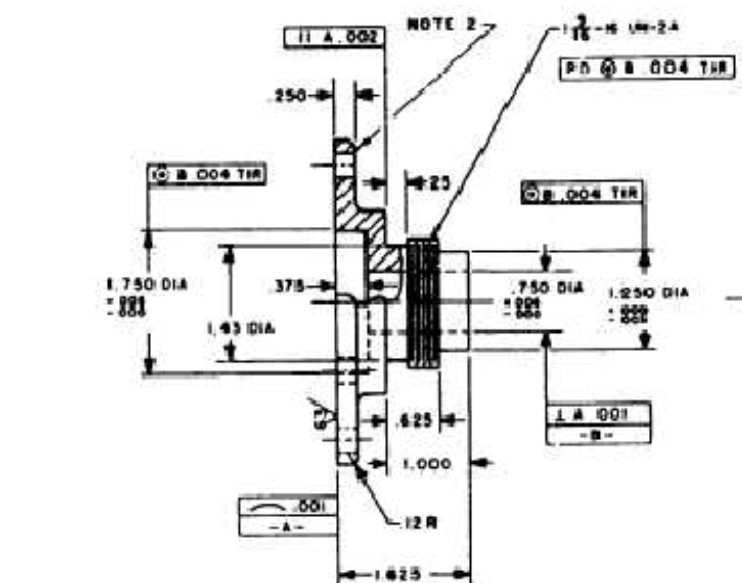thread1103-215826
I have recently had an internal discussion at my company over whether or not to include Basic dimensions in an AS9102 First Article. The answer is yes you do. Pure and simple. To do otherwise is not complying with the AS9201 Standard. Basic Dimensions are part of the design characteristics on the drawing.
I read in one post "BASIC dims have no tolerances by themselves. They are nominals. Measuring their location directly violates the design intent and provides no useful information within the context of their design intent. A direct measurement of a BASIC dim does nothing to say if the feature is in tolerance. If one feels it is necessary to measure directly, they need to invoke some other method of tolerancing instead of BASIC."
I'm not sure why that person stated that, but measuring them directly is what you need to do to find Position. True that are nominals but so are that non-Basic dimensions. If I have a part that has a Hole and uses Cartesian dimensions showing the Hole Diameter, the X location and Y Location with ± tolerances everyone agrees that we record the Hole Diameter, the X and Y dimensions on the FAI Plan and measure directly from their respective surfaces on the FAI report. Fine we all agree on that principle. Why does anyone think it's different with geometric tolerancing. , Document the Hole Diameter with a ± tolerance, Basic Dimensions for X & Y direction, and Position tolerance Feature Control Frame. Yes the X & Y BASIC dimensions are theoretical however they ARE directly measured from the DATUM features called out in the Feature Control Frame. Those actual dimensions are recorded and compared to the basic dimensions to find the delta from each X & Y Basic Dimension (True Position). The outcome after the position calculation is called Position (Actual Position from the theoretical True Position in a diametrical circle/cylinder). So the Hole is measured DIRECTLY and related back to the DATUM Schema in a Cartesian manner (can be Polar too). The Basic dimensions have a tolerance when combined but not on there own. Both measurement directions must be ascertained to compute the actual Position within the Tolerance specified in the Feature Control Frame.
There are more cases of Basic Dimension use per ASME Y14.5-2009 that can be discussed. For instance, Basic Dimensions used to locate DATUM targets. Best Practice is to include those in the FAI to show the FAI approver that they were achieved by using whatever device to achieve those Basic dimensions( like Gage Blocks). Simply record the dimension you created with the gage block that you created the DATUM Targets . Now some may come back and say that's redundant but I can tell you it will always pass and external audit without question. Not putting characteristics that are on the Drawing (excluding Reference Dimensions per AS9102) can lead to auditors asking questions and you having to justify why that they may or may not accept.
I have recently had an internal discussion at my company over whether or not to include Basic dimensions in an AS9102 First Article. The answer is yes you do. Pure and simple. To do otherwise is not complying with the AS9201 Standard. Basic Dimensions are part of the design characteristics on the drawing.
I read in one post "BASIC dims have no tolerances by themselves. They are nominals. Measuring their location directly violates the design intent and provides no useful information within the context of their design intent. A direct measurement of a BASIC dim does nothing to say if the feature is in tolerance. If one feels it is necessary to measure directly, they need to invoke some other method of tolerancing instead of BASIC."
I'm not sure why that person stated that, but measuring them directly is what you need to do to find Position. True that are nominals but so are that non-Basic dimensions. If I have a part that has a Hole and uses Cartesian dimensions showing the Hole Diameter, the X location and Y Location with ± tolerances everyone agrees that we record the Hole Diameter, the X and Y dimensions on the FAI Plan and measure directly from their respective surfaces on the FAI report. Fine we all agree on that principle. Why does anyone think it's different with geometric tolerancing. , Document the Hole Diameter with a ± tolerance, Basic Dimensions for X & Y direction, and Position tolerance Feature Control Frame. Yes the X & Y BASIC dimensions are theoretical however they ARE directly measured from the DATUM features called out in the Feature Control Frame. Those actual dimensions are recorded and compared to the basic dimensions to find the delta from each X & Y Basic Dimension (True Position). The outcome after the position calculation is called Position (Actual Position from the theoretical True Position in a diametrical circle/cylinder). So the Hole is measured DIRECTLY and related back to the DATUM Schema in a Cartesian manner (can be Polar too). The Basic dimensions have a tolerance when combined but not on there own. Both measurement directions must be ascertained to compute the actual Position within the Tolerance specified in the Feature Control Frame.
There are more cases of Basic Dimension use per ASME Y14.5-2009 that can be discussed. For instance, Basic Dimensions used to locate DATUM targets. Best Practice is to include those in the FAI to show the FAI approver that they were achieved by using whatever device to achieve those Basic dimensions( like Gage Blocks). Simply record the dimension you created with the gage block that you created the DATUM Targets . Now some may come back and say that's redundant but I can tell you it will always pass and external audit without question. Not putting characteristics that are on the Drawing (excluding Reference Dimensions per AS9102) can lead to auditors asking questions and you having to justify why that they may or may not accept.


![[smile] [smile] [smile]](/data/assets/smilies/smile.gif)